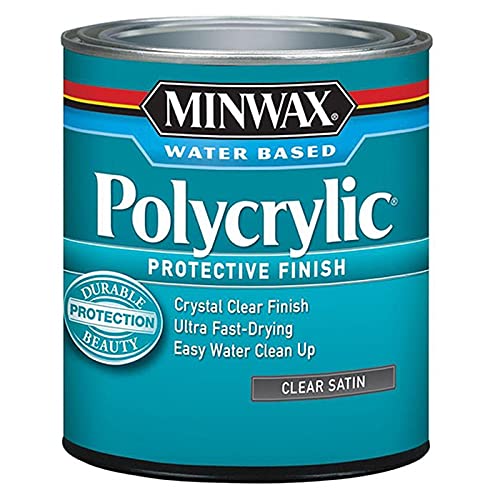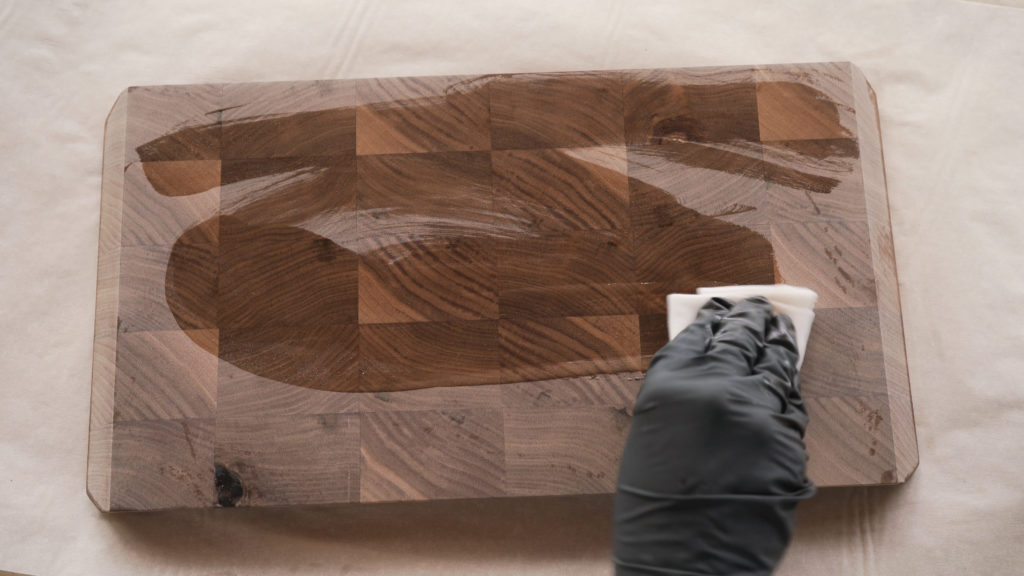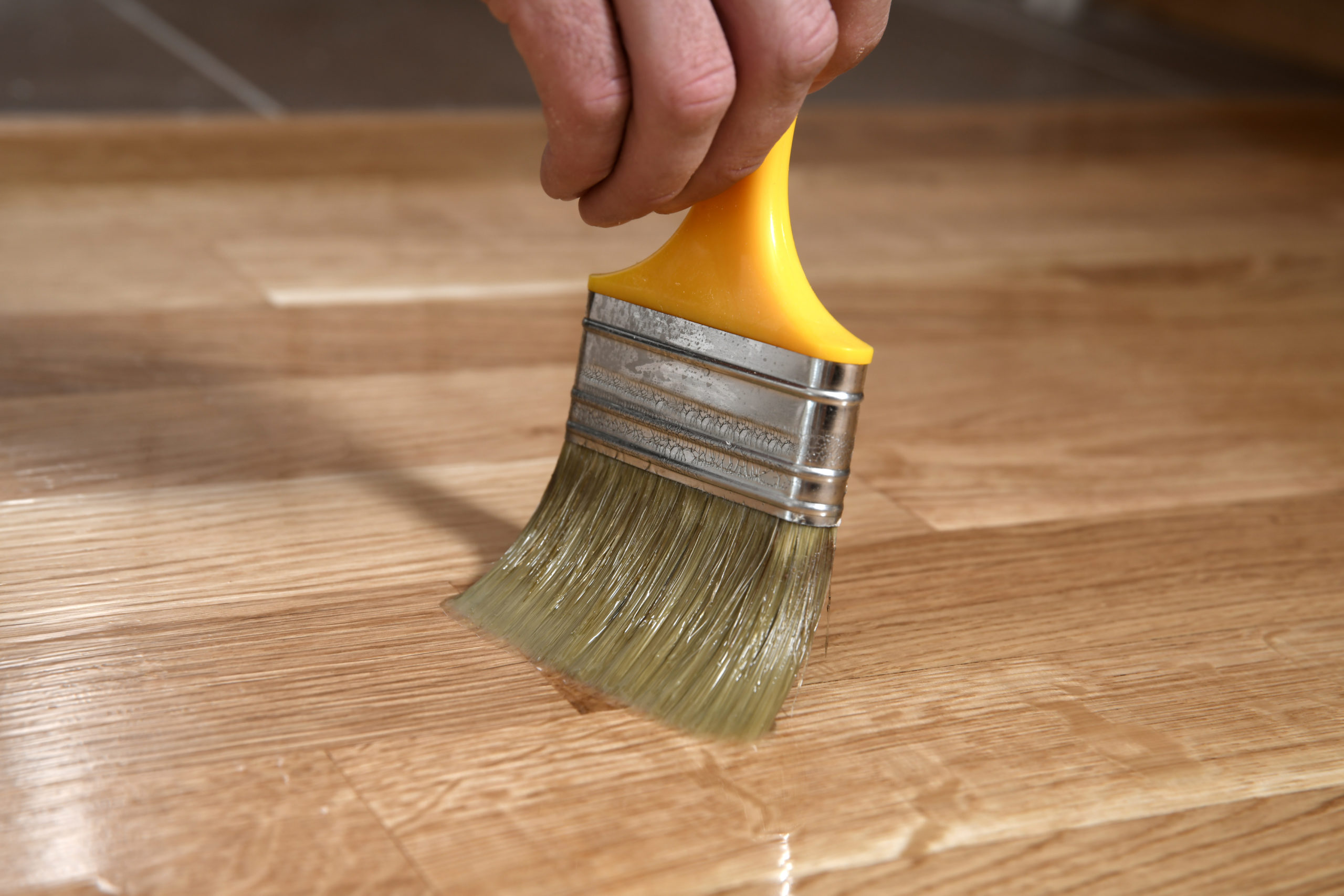How To Apply Clear Coat On Wood
Buying the best clear wood finish involves understanding drying time, toxicity, ease of application and yellowing of the wood. While a clear coat for wood can enhance the grain and appearance it's best to choose a brand name product that the professionals use vs. big box brands you might be familiar with.
Wood finishes are messy and old-school polyurethane is a MESS to put on and wait a day to dry.
Which is why for more than two decades I've only used General Finishes Arm-R-Seal for my kitchens, furniture, trim, porch ceilings and many other woodworking projects.
But, while a great finish, there are other clear wood finishes to consider for outdoor use, low toxicity (VOC), and other uses.
In this article learn what the best finish for your project is as we cover:
- Types of clear wood finishes
- Difference between penetrating and surface finishes
- Finishes for indoor and outdoor projects
- Finishes that won't yellow (UV tolerance)
- Wood finish toxicity
- Clear coat options for butcher blocks
- Hard, waterproof clear finishes like epoxy
- Best ways to apply a finish
- Best clear wood finishes
- And, durable finishes for both indoor and outdoor use
| Finish | Product Desc. | Shop |
|---|---|---|
 | Editor's Pick: General Finishes water based, fast drying | CHECK PRICE |
 | Best Non-Yellowing: Minwax polycrylic | CHECK PRICE |
 | Best Spray On: Deft spray finish | CHECK PRICE |
 | Best Outdoor: Total Boat marine grade | CHECK PRICE |
 | Sanding sponge: Required with most finishes to sand sealer coats for smooth finish | CHECK PRICE |
 | Color Putty: Hide nail holes and cracks by wiping on and off in seconds | CHECK PRICE |
Types of Clear Coat for Wood

From cabinets to furniture and food safe surfaces like a butcher block there are a wide variety of options when choosing a clear coat for wood projects.
But, and we'll get to this later in more detail, there are two broad categories of wood finishes: surface finishes and penetrating finishes.
In general, you'll use a surface finish for cabinets, furniture, trim and other surfaces as it "builds up" to provide a protective coat.
On the other hand, a penetrating finish like tung oil protects the wood from within and, with proper choice, are food safe.
Best Clear Wood Finishes for Indoor Projects
For surface finishes there are a broad variety of finishes and application types. Here's an overview of these finish types by their primary characteristics:
- Water resistant: a urethane or polyurethane finish is best. Common for cabinets, floors, trim and furniture.
- Waterproof: an epoxy finish is most common (and durable). Epoxy is used for bar tops where water and glasses are tough on wood.
- Indoor low toxicity: to reduce the stink and chemicals, using a polycrylic or water-based polyurethane is common.
- Non-yellowing: one of the hallmarks of a polycrylic is its resistance to UV-fading and yellowing that is common with other polyurethane.
- Food safe – from literally the Tung tree, a tung oil is most popular, but mineral oil and a few other conditioners are also common.
Best Clear Wood Finishes for Outdoor Projects
Moving outdoors, you'll find a variety of applications from direct water contact to finishes for indirect sun and water:
- Waterproof: a spar varnish is the gold standard for waterproof exterior finishes, but exterior epoxies exist as well.
- Penetrating oil: for finishing exotic woods like Jatoba there are No products found. for wood furniture that are safe to use outdoors.
- Water resistant vertical surfaces: for direct sun and water contact a water based topcoat like the General Finishes 450 is popular.
Guide to the Best Clear Wood Finishes
Based on my decades of woodworking experience, here's my list of the best available clear wood finish:
1. General Finishes Urethane (Best Clear Wood Finish)
Wipe on urethanes, like a General Finishes urethane, are easy to use and make a perfect finish for any skill level. No brushes, dries very fast, and works on trim and large surfaces equally well.

Overview
- Type: Urethane (surface)
- Composition: Oil based
- Application: Wipe on
- Uses: Cabinets, furniture, trim, etc.
- Indoor/Outdoor: Indoor
Urethane Wood Finishes
First, I've sprayed hundreds of gallons of high toxicity pre-catalyzed lacquer. And while that type of (professional) finish is fantastic, it's not a DIY'ers option or safe to apply without the right protective gear.
So, for my home woodworking projects, 20 years ago I switched to a urethane wipe on finish (I use General Finishes, above). And the results? A comparable finish without spraying.
What do I like about a urethane finish? It holds up incredibly well to water and wear, it goes on with a cloth, dries in 15-20 minutes and is easy to sand between coats.
Like most clear finishes you will want 2-3 coats for a smooth, clear finish. And I like to use a sanding block after the first coat to create a perfectly smooth final finis
- Best overall indoor sealing
- Fast drying
- Easy to sand
- Easy to apply
- Oil based, higher toxicity
2. Polycrylic Clear Wood Finish For Interior Projects
Polycrylic is a low VOC, water-based finish that will not yellow over time and is easy to apply.

Overview
- Type: Polycrylic (surface)
- Composition: Water based
- Application: Brush on
- Uses: Cabinets, furniture, trim, etc.
- Indoor/Outdoor: Indoor
Polycrylic Wood FInishes
A polycrylic is a water based, less toxic finish that applies easily and dries fast in the right (low humidity) conditions.
If you are looking for a less noxious clear wood finish then using a polycrylic is a great option to more noxious oil-based finishes. And, this finish is DIY friendly.
Key features:
- Dries in 2-3 hours
- Water-based
- Covers evenly
- Cloth-based application (no brushes)
- Will not yellow like oil-based finishes
And like most clear finishes you will want 3+ coats. But for water-based finishes I recommend an extra coat. You can learn more in our guide to applying polycrylic.
- Best for Indoor Use
- Non-yellowing
- Water based for lower toxicity
- Requires careful application on large surfaces to avoid white film
3. Spar Varnish Exterior Clear Wood Finish
Spar varnish produces a hard, clear finish that protects wood from water damage and has been used for decades on marine-grade projects.

Overview
- Type: Varnish (surface)
- Composition:Solvent based
- Application: Brush on
- Uses: Exterior wood projects, boats
- Indoor/Outdoor: Outdoor
Spar Varnish Wood Finish
Rust-Oleum Spar Varnish is a marine grade clear finish that is great for exterior applications where the finish will be exposed to water.
First, not all finishes were made to be in contact with water. But Spar varnish is one of the exceptions and was made for contact with water.
Key features:
-
- Exterior finish
- Expands and contracts with weather condition changes
- Durable
- UV protection
Key drawbacks? Well, this finish is tougher to apply and isn't suited to most interior applications. And you'll need to use protective masks and gloves as this is a solvent based finish.
- Made for outdoor use
- UV, salt and mildew resistant
- Protects wood from water damage (non-submerged)
- Can be difficult to apply smoothly
4. Clear Epoxy Resin Finish for Bar Tops
A two part epoxy resin works for bar tops or filling live edge tops of any shape. An epoxy is recognized as extremely hard and is what you'll find on bartops due to it's durability and toughness.

Overview
- Type: Epoxy (surface)
- Composition:Solvent based
- Application: Poured
- Uses: Interior (bar, tables)
- Indoor/Outdoor: Indoor
Epoxy Wood Finish
A two part epoxy forms a clear, hard wood finish that is perfect for bar tops or epoxy tops.
While more difficult to work with and perfect, an epoxy finish produces an amazing clear and durable coat on wood. And due to it's composition it has excellent resistance to water, abrasion and dings.
Key features:
- Two part mixture
- Fast drying times (30-60 minutes working time)
- Avoids "fish eyes" and craters
- Bubbles can be burned off during drying with a blowtorch or heat gun
While this finish may seem intimidating, with a long working time you'll be able to adjust your approach. But make sure you have a level surface first and a heat gun for bubble control.
- Exceptional durability to dings
- Excellent water protection
- Hard, clear finish
- Difficult to apply
- Can bubble during application
- Expensive
5. Clear Lacquer Spray Finish In a Can
A spray lacquer is perfect for small surface projects with uneven features that wouldn't accept a brushed or wiped finish.

Overview
- Type: Acrylic (surface)
- Composition:Solvent based
- Application: Sprayed
- Uses: Small or intricate surfaces
- Indoor/Outdoor: Indoor
Spray Lacquer Wood Finish
First up is understanding that lacquer is an acrylic-based spray and a protective mask rated for chemical use is a must.
I've occasionally used a spray like this for touch-ups and small projects where I didn't want to use my HVLP sprayer.
Other uses include application over old finishes or even paint. But, make sure you test it on a small (non-visible) area to make sure the solvents do not damage the existing coats.
- Durable finish
- Spray on for easy use
- Fast drying
- Acrylic-base requires protective mask
- Not suited for large surfaces
- Overspray can leave a rough or clouded finish on intricate projects
6. Tung Oil Clear Wood Finish for Butcher Blocks
Tung oil is a penetrating clear wood sealer that has been used for centuries to seal wood and is favored in kitchens and cutting blocks

Overview
- Type: Penetrating
- Composition:Natural oil
- Application: Wiped on
- Uses: Cutting boards, all wood projects
- Indoor/Outdoor: Indoor
Tung Oil Wood Finish
This penetrating wood finish can be used on a variety of projects, including:
- Food safe cutting boards
- First finish on wood projects, and then later seal them (eg. with urethane or lacquer)
- Weathered wood
- Brick, stone and cast iron
So what gives tongue oil the distinct status of a wood finish that is food safe?
Well, tongue oil is made from compressing the roots of (you guessed it) the Tung tree. Once extracted, applied to your project, it dries when exposed to air and forms a sealant deep within the wood.
- Deep penetrating
- Non-toxic
- Food safe (verify with brand!)
- Doesn't require a surface sealant (but it will work with them)
- Alters color of wood grains (can yellow)
7. Polycrylic Spray - Clear Wood Finish
A polycrylic spray converts the water-based clear finish typically brushed on into a spray can that produces a clear finish with a dry time to recoat in as little as 2 hours.

Overview
- Type: Surface
- Composition: Water based
- Application: Spray
- Uses: Smaller and irregular projects
- Indoor/Outdoor: Indoor
Spray Polycrylic Wood Finish
Combining all of the features of the wipe or brush-on polycrylic but converting it to a spray can, this type of finish is quick and easy for all projects. And, as a spray can, it can be used for minor touch-ups of projects that may have been damaged during transport or installation.
- Easy to apply
- No cleanup
- Convenient spray-on finish
- Same properties as traditional polycrylic
- Can leave overspray on larger surfaces
What is a Clear Wood Finish?
Before we begin, let's take a look at just what a clear wood finish is.
A clear wood finish can take two forms:
- Penetrating finish like tung oil that penetrates the wood and seals the wood pores
- Surface coat like lacquer or polyurethane that forms a layer on top of the wood
And, these can be used separately or together based on your project and desired aesthetics.
Types of Clear Wood Finishes
Now that we've broken wood finish into two categories (penetrating and surface) let's take a look at what types of finishes there are in each category.
Because wood projects can range from cutting boards to furniture to outdoor benches and tables there is no one-size-fits-all clear finish for projects.
And if you factor in visual preference, UV protection, anti-yellowing, and toxicity of application there are an even wider range of finishes to consider.
Penetrating Clear Wood Finishes

A cutting board is a great example of where a clear finish is desired and the finish cannot be on the surface.
So what types of finishes can offer protection to the wood?
Fortunately there are solutions that have been used for 2000+ years (Tung oil) that are plant based and food safe.
Common Penetrating Finishes
- Tung Oil (plant-based, clear)
- Boiled Linseed Oil (plant-based, yellowing)
- Mineral Oil (non-toxic, food safe)
Applying a Penetrating Finish
These types of finishes are among the easiest to apply.
First, make sure your projects surface preparation is complete, fully sanded, and clean of all dust and debris.
Then simply follow the directions on the oil you have chosen.
A few pointers:
- Always use clean, food-safe rags if you are working with pieces like a butcher block
- Drying time can vary from a few hours to a few days with a penetrating finish
- Follow directions for multiple coats
- And, remember multiple coats can lead to build-up you may not want
With some projects, like a butcher block, you'll be able to apply a tung oil many times over the life of the piece.
Toxicity of Penetrating Finishes
Most penetrating clear finishes are toxin free, however check the individual supplier and remember to check the actual composition. For example, some Tung oil (pressed from the Tung tree) are imitation.
Surface Clear Wood Finishes

By far the most popular type of clear wood finish, a surface finish will provide a durable topcoat.
Common Surface Finishes
- Lacquer
- Polyurethane
- Shellac
- Epoxy
- Polycrylic
Applying Surface Finishes
These finishes range from easy to hard to apply.
While some finishes wipe on with a rag, others require High Volume Low Pressure (HVLP) spray systems for the best finish.
What's best for your project? Well, I consider budget and avoiding toxic fumes first, but humidity, drying time and your skill all play into choosing a clear wood finish.
Toxicity
The toxicity of finishes is something to watch.
While water-based finishes are generally less toxic than a solvent finish there are still toxins to keep track of.
What should you look for? First, the common language is Volatile Organic Compounds (VOC's) and the Underwriters Laboratory has a GREENGUARD program that certifies products seeking to be greener.
But, be sure to always use protective equipment when finishing wood to ensure you're minimizing contact, use ventilation, respirators and all other safety equipment as specified by the manufacturer.

Last update on 2021-11-25 at 21:26 / Affiliate links / Images from Amazon Product Advertising API
Clear Wood Finish Application Tips
So you've decided on a finish.
Now the hard part of making sure your wood project is ready for the finish. And you have all the right supplies on hand to make the finish turn out the best.
Tip #1 - Make sure the wood is sanded properly
I've seen so many projects go bad with the wood not having the right finish sanding. To avoid this simply follow these steps:
-
- For new construction projects use a tool like a belt sander to remove extra wood and create a flat surface.
- My favorite tool is an orbital sander as it can remove a large amount of wood with a 40-grit sanding disc and be the finish sander with a 320-grit disc. Use this sander to remove any scratches and prepare the wood for a final sanding.
- Use a pad or palm sander with a high grit number (200+) to remove any orbital sander swirls.
- For uneven surfaces use a sanding block to remove any raised grain.
For help on which sanders to use refer to the guide to the best wood sanders.
Tip #2 - Use the proper safety equipment
Even a water-based finish has a level of toxicity that you should be careful with.
And lacquer or other chemical-based finishes absolutely require safety equipment. Beyond using a ventilated area be sure to use:
-
- Paint-grade respirator
- Chemical gloves
- Eye protection
Tip #3 - Test on a Small Piece First
I have an imprint of an orbital sander on my insulated garage door.
Many years ago I attempted a tricky color match on a maple desk top – which is extremely hard to do with a blotch-prone hard maple project. And after many redo's and touch-ups (and a late nite) was frustrated at the process.
What I would have done different? Use a test piece of maple first, found the right application process AND THEN tackled the larger surface.
While applying a clear wood finish may not have the same level of difficulty, if you're new to wood finishes try a test piece of the backside of your project first to get the hang of it.
How To Apply Clear Coat On Wood
Source: https://thehomewoodworker.com/clear-wood-finish-coat/
Posted by: schofieldthatuagaild.blogspot.com

0 Response to "How To Apply Clear Coat On Wood"
Post a Comment